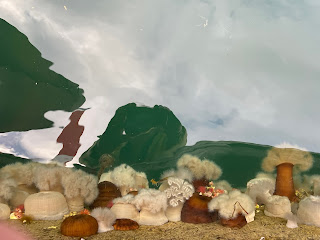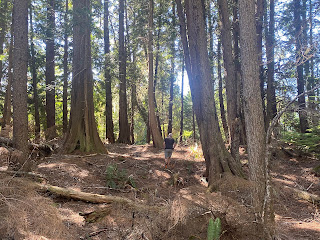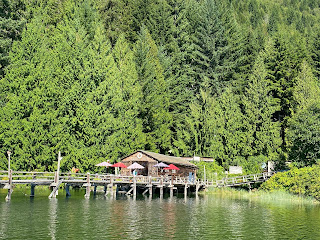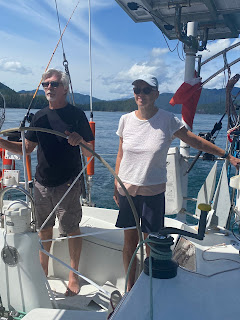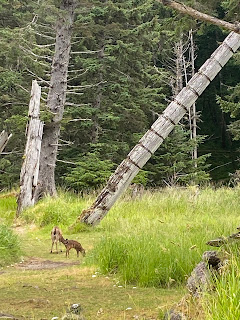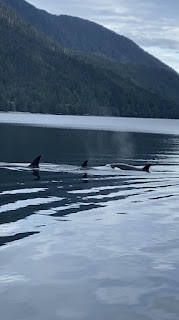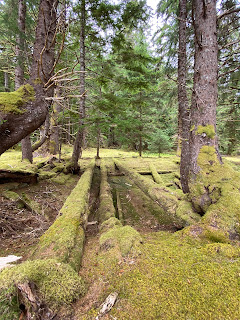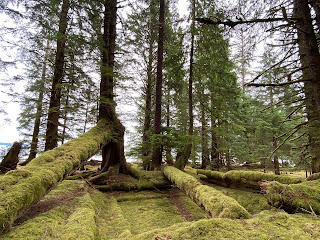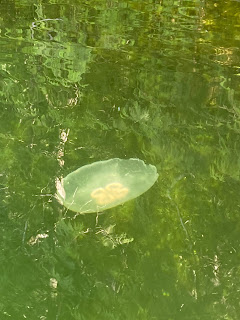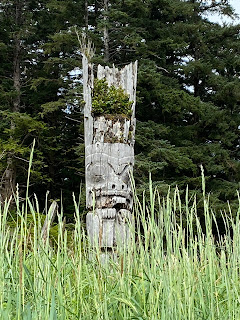After
motoring in the fog for several hours, the skies cleared and we anchored out at
Shearwater as the docks were full. We
were tired, fished out, and cranky. A
few stiff drinks and showers on board improved the mood significantly.
I awoke to a
messy boat and numerous projects underway; engine oil change, leg oil top up, engine
belt replacement, and water pump replacement. Over morning coffee, I watched in awe as 2 humpback cruised through the
anchorage and the Shearwater Marina, surfacing directly beside the fuel dock..
After Shearwater we enjoyed two new-to-us anchorages: Kayak Cove and Pruth Bay. Kayak Cove was super special as there is a good fishing spot just outside the cove. Greg caught a 32 inch chinook the evening before anchoring and a 19 inch coho in the morning. It is almost comical on our awkward sailing platform, joining the processions of guided fishing boats from the nearby lodges and then bringing in big fish of our our own right beside them. Pruth Bay is a beautiful spot with walking trails and numerous sandy beaches. It is the site of the Hakai Beach Institute and is a regional collaborative center of Ocean Science. We noticed several University students here working on their research. We walked to West Beach and North Beach and at North Beach we watched a group of orcas feeding.
The weather has been changing. It is often cold, foggy, and rainy. After Pruth Bay, we motored in the rain in the company of 4 orcas and a humpback to Pierce Bay. I won’t easily forget Pierce Bay. In the morning, Greg was eager to go before I finished my first cup of coffee, though we can’t really say he is to blame. I was driving and edged over to the left to avoid some debris in the water. I was looking with my long distance glasses at Navionics on my phone, making the little red box unnoticeable and combined with lack of caffeine, debris, and early morning brain fog, I clunked into an underwater rock at 3 knots and bounced off. Even though it was not a super hard collision it was extremely upsetting. Then, when proceeding further out of the channel, my phone GPS stopped updating, so I was even more rattled. It was a rough morning. As we carried on the wildlife did their best to cheer us up. During the day we saw 5 otters, a humpback chasing a sea lion, a muskrat swimming, a large flock of seagulls on a feeding frenzy. The daily fishing report for keeper fish was a 26 inch chinook and a persimmon rockfish. A few other small rockfish and a small halibut were released.
The night
was spent at Skull Cove. We were here
in June when Adrian and Gavin joined us on the boat. Still reliving the trauma from the rock
strike yesterday, I totally lost my cool in the morning while heading out in thick
fog. The channel was narrow and I
couldn’t see a thing. My phone GPS again
stopped updating on my Navionics so I was totally disoriented with Greg seemingly
directing me to drive into a rock wall. So, when in doubt, stop the boat, and let Greg drive.
After most
of the day motoring in heavy fog (thankful for AIS and boats that use it) we
anchored amongst the crab pots at Port McNeil. We spent the day catching crabs
and ferrying large quantities of booze and food aboard the boat. Greg’s brother-in-law, Brent, and his partner,
Darlene, joined us for the next 6 days heading south.
The first few days with Brent and Darlene were a delight exploring the indigenous sights in the Broughton Archipelago. We saw the Chief’s Bathtub rock depression and the pictograph of a face at Berry Island. We next anchored at Village Island to go ashore and visit Mimkwamlis, the Mamalilikulla First Nation site. This was extra special, as 30 some years ago, we visited the same site with our 3 young boys. We came across some of the same fallen poles as we had seen many years ago, but in a state of substantially advanced decay. The midden here is an amazing 18 feet deep. At Mound Island we explored the 14 depressions and fallen poles of native big houses. On the way to Lagoon Cove, we motored past Karlukwees site and saw the Nicholas Point pictographs as we had also seen them at this spot 30 years ago with the kids .
Lagoon Cove was a nice "tied to a dock" break. We joined the 5:00 daily potluck hour hosted by the owners, who serve up prawns.
After
Lagoon Cove, we passed through Chatham Channel at slack and headed to 17-26 knots
of a NW breeze in Johnstone Strait. This
was Darlene’s and Brent’s introduction to wind, waves, cold, and also a wee bit of boat chaos. When driving I can tack better than I can gybe and
I totally oversteered through one gybe in 24 knots of breeze. I nicely laid the boat over on its side (called a broach in sailing lingo), but sheets were released, the boat stood back up and we carried on. Brent and Darlene took it well.
It takes a
bit of planning, but we got through both Wellborne Rapids and Green Point Rapids
close to slack water to arrive at Cordero Anchorage. The sun broke through and I had a dip in
13.3 C degree water, and my margarita was well earned.
There was more hard core conditions the next day heading to Small Inlet on Quadra Island. We were all dressed in foulies, travelling through heavy rain and fog. We cranked up the diesel heater, making the boat cozy below.
North of Seymour Narrows, a large chinook was hooked for Brent while we waited for slack at the narrows. With our freezer already full of salmon and crab bait, we persuaded Brent and Darlene to take the six nice chinook cuts home. Brent and Darlene waved goodbye to us at Campbell River and we hurried to get ready for Gavin, Kelly, and Simon to join us that evening for the last 4 days of home-bound sailing.
With keen fishermen on the boat once again, the next days were a blur of being underway at
sunrise to fish, tolerating lumpy seas to fish, and scheduling everything
around fishing. Sadly, for the keeners aboard the salmon we caught south of Campbell River were all thrown back as either undersized Chinook or non-retention Coho. Compensation was provided by large and mighty other wildlife. We saw numerous orcas
and humpbacks. We stopped to watch a humpback that was playing
with a large log, bumping it and rolling it on its back. Perhaps some sort of whale yoga or Tai Chi? Afterwards we had a calm night at Stuart Bay on Texada Island and the next day at Thormanby
Island.
With the
trip nearing to a close, our last night was at the marina in Gibsons. We eased back into urban life with tasty drinks
and oysters at Smitty’s Oyster Bar.
Unfortunately it often seems that the last leg of our trips brings havoc. On the final part of our journey back to Vancouver Greg finally won me over and the spinnaker emerged from its deep storage in the quarter berth. Gavin was an eager accomplice so in light wind up went the A3 spinnaker. This went well until we emerged into confused waves near Point Atkinson and winds increased to 20 knots. Nobody except for Greg knew anything about flying a spinnaker so we had a messy sail in further strengthening breeze with 4 roundups while I was driving. We were trying out a spinnaker sock arrangement which is supposed to make it easier to fly the spinnaker, but nothing we have tried short of having a full racing crew aboard has made spinnaker hoists and take downs much easier. This time the snuffer sock got locked at the top of the mast so in more than 25 knots of breeze a traditional takedown was urgently needed. We were closing the distance between us and the freighters, kite surfers, and dingy sailors on English Bay at speed. Amazingly the take down went well, but meanwhile there was yelling. There were also dark thoughts and later, talking about it all, there was family strife. Bloody Greg and his spinnaker.
It was a stressful finish to an otherwise fabulous trip to Haida Gwaii and back. Sailing at times combines the best and the worst of life. Dark thoughts have now subsided and despite a few troubles along the way it really was a terrific summer spent at sea.








